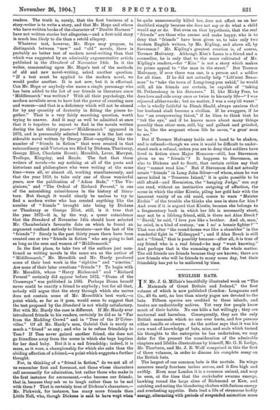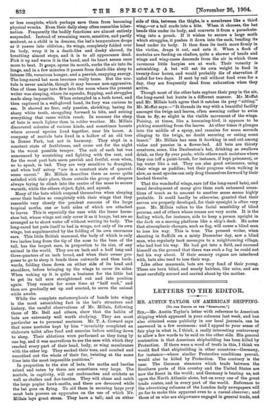The largest of our common bats is the noctule. Its
wings measure nearly fourteen inches across, and it flies high and swiftly. Even near London it is a common animal, and may be seen, at the time that the cockchafer swarms emerge, hawking round the large elms of Richmond or Kew, and catching and eating the blundering chafers with furious energy and everlasting appetite. Bats lead a life of strenuous bodily energy, alternating with periods of suspended animation more or less complete, which perhaps save them from becoming physical wrecks. Even their daily sleep often resembles hiber- nation. Frequently the bodily functions are almost entirely suspended. Instead of remaining warm, sensitive, and partly sentient, as a child is in dreams, the bat's temperature drops as it passes into oblivion ; its wings, completely folded over its body, wrap it in a death-like and dusky shroud, its breathing almost stops, and it is to all appearance dead. Pick it up and warm it in the hand, and its heart seems once more to beat. It gasps, opens its mouth, sucks the air into its lungs, and in a few minutes it passes from death-like sleep to intense life, voracious hunger, and a peevish, snapping energy. The long-eared bat soon becomes really tame. But the noc- tule is never amiable, though it may become non-aggressive. One of these large bats flew into the room where the present writer was sleeping, where its squeaks, flapping, and struggles made sleep impossible. When entangled in a bath towel, and then captured in a well-gloved hand, its fury was curious to see. It showed no fear, only passion, shrieking, baring its sharp white teeth, struggling forward to bite, and seizing everything that came within reach. In summer the sleep of bats is much lighter than in colder weather. Mr. Millais discovered colonies of various kinds, and sometimes haunts where several species lived together, near his house. A company of noctule bats lived in a hollow of an old tree in Denne Park, but not in harmony. They slept in a constant state of fretfulness, and came out for the night in the worst possible temper. The exit of each bat was announced by scratching and fighting with the rest, and for the most part bats seem peevish and fretful, even when, so to speak, in bed. They are very sensitive to draughts, and when half asleep " are in a constant state of quarrel- some unrest." Mr. Millais describes them as never quite satisfied with their place, those outside the group of sleepers always trying to climb into the centre of the mass to secure warmth, while the others object, fight, and squeak.
Many of the bats which suspend themselves when sleeping cover their bodies so completely with their wings that they resemble very closely the pendent cocoons of the large tropical moths, one or both sides of which are attached to leaves. This is especially the case with the lesser horse- shoe bat, whose wings not only cover it as it hangs, but are so arranged as to shoot water off without wetting its body. The long-eared bat puts itself to bed in wraps, not only of its own wings, but supplemented by the folding of its own enormous ears. This little British mammal, the body of which is only two inches long from the tip of the nose to the base of the tail, has the largest ears, in proportion to its size, of any animal in the world. They are an inch and a half long and three-quarters of an inch broad, and when their owner pro- poses to go to sleep it bends them outwards and then back- wards, folding them down on either side of its head and shoulders, before bringing up the wings to cover its sides. When waking up it is quite a business for the little bat to get its tall ears straightened out and into position again. They remain for some time at "half cock," and then are gradually set up and erected, to serve the animal while awake.
While the complete metamorphosis of hands into wings is the most astonishing fact in the bat's structure and history, the careful observations of Mr. Millais, following those of Mr. Bell and others, show that the habits of bats are extremely well worth studying. They are most particular as to personal neatness. Mr. T. A. Coward says that some noctules kept by him " invariably completed an elaborate toilet after food and exercise before settling down to sleep. Their ablutions were performed as they hung by one leg, and it was marvellous to see the ease with which they reached every part of their head, body, or wing membranes with the other leg. They sucked their toes, and combed and smoothed out the whole of their fur, twisting at the same time into the most impossible positions."
In proportion to the size of bats, the moths and beetles seized and eaten by them are sometimes very large. The noctule, in captivity, will eat cockroaches and crickets as well as chafers and dor-beetles. They will chase and catch the large poplar hawk-moths, and these are devoured while the bat goes on flying. To aid them in securing large prey most bats possess an apparatus on the use of which Mr. Millais lays great stress. They have a tail; and on either side of this, between the thighs, is a membrane like a third wing,—or a tail made into a kite. When it chooses, the bat bends this under its body, and converts it from a parachute- wing into a pouch. If it wishes to secure a large moth which struggles, it pushes it down into the sack, bending its head under its body. It then fixes its teeth more firmly in the victim, drags it out, and eats it. When a flock of noctules are feeding on chafers, quite a shower of heads and wings and wing-cases descends from the air in which these ravenous little harpies are at work. Their voracity is astonishing. A bat will eat its own weight in food in twenty-four hours, and would probably die of starvation if unfed for two days. If sent by rail without food even for a day, they are frequently dead from exhaustion when they arrive.
Though most of the other bats capture their prey in the air, the long-eared bat hunts in a different manner. Mr. Moffat and Mr. Millais both agree that it catches its prey " sitting." Mr. Moffat says:—"It threads its way with a beautiful facility amongst the twigs and leaves, often seeming rather to swim than to fly, so slight is the visible movement of the wings. Poising, at times, like a humming-bird, it appears to be picking something from the leaves. At other times it plunges into the middle of a spray, and remains for some seconds clinging to the twigs, no doubt securing or eating some insect." Mr. Millais has seen it hawking in and out among violas and pansies in a flower-bed. All bats are thirsty creatures, some, like Daubenton's bat, drinking as swallows drink, as they fly over pools; while others suck moisture where they can (off a paint-brush, for instance, if kept prisoners), or lap water like a cat. They are also good swimmers, using their wings as paddles; but their progress when walking is slow, as most species can only drag themselves forward by their hooked thumbs.
That the wonderful wings, ears (of the long-eared bats), and nasal development of many give them such enhanced sensa- tions of touch as to amount to another sense seems highly probable. It could hardly be otherwise, granted that their nerves are properly developed, for their eyesight is often very poor. Mr. Millais refers to the facial sensibility of blind persons, and of others whose senses are very acute. It is the feeling which, for instance, aids to keep a person upright in the dark on a moving platform like a ship's deck. He notes that atmospheric changes, such as fog, will cause a blind man to lose his way. This is true. The present writer, when shooting in Suffolk on a misty December day, saw a blind man, who regularly took messages to a neighbouring village, who had lost his way. He had got into a field, and excused himself on the ground that there was such a fog be could not feel his way about. If their sensory organs are interfered with, bats also tend to lose their way.
Like other mammals, bats are very fond of their young. These are born blind, and nearly hairless, like mice, and are most carefully nursed and carried about by the mother.















































 Previous page
Previous page